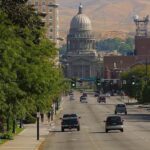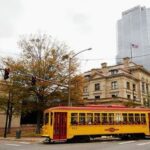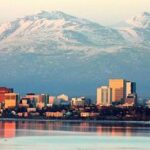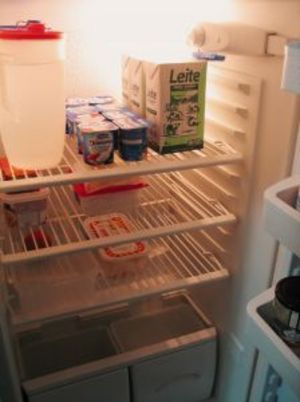This article, the fourteenth in a 50-state series, lists the twenty largest cities in Indiana by population size and provides demographic details for each city: total population, population by age group, racial composition of the population, land area, and population density. For purposes of this article, cities are incorporated municipalities and census-designated places (CDPs).
After reading “Largest Cities in Indiana (2012),” return to this link to read “Best Places to Live in Indiana (2012).”
Similar articles for the remaining 49 states can be found at these links: Alabama, Alaska, Arizona, Arkansas, California, Colorado, Connecticut, Delaware, Florida, Georgia, Hawaii, Idaho, Illinois, Iowa, Kansas, Kentucky, Louisiana, Maine, Maryland, Massachusetts, Michigan, Minnesota, Missouri, Mississippi, Montana, Nebraska, Nevada, New Hampshire, New Jersey, New Mexico, New York, North Carolina, North Dakota, Ohio, Oklahoma, Oregon, Pennsylvania, Rhode Island, South Carolina, South Dakota, Tennessee, Texas, Utah, Vermont, Virginia, Washington, West Virginia, Wisconsin, and Wyoming.
1. Largest Cities in Indiana (2012): Indianapolis, IN
Located in central Indiana, Indianapolis is the state’s capital and largest city with an estimated population of 820,445.
Grouped by age, 25.0% of the population is under 18, 10.6% is 18 to 24, 29.4% is 25 to 44, 24.5% is 45 to 64, and 10.5% is 65 or older. The median age of the population is 33.7.
The racial composition of the city is 61.8% White, 27.5% Black or African American, 0.3% Native American, 2.1% Asian, 5.5% from other races, and 2.8% from two or more races. The population is 9.4% Hispanic or Latino of any race.
The land area of the city is 365.1 square miles. The city’s population density is 2,247 people per square mile.
2. Largest Cities in Indiana (2012): Fort Wayne, IN
Situated in northeastern Indiana, Fort Wayne is the second largest city in the state with an estimated population of 253,691.
Classified by age, 26.4% of the population is under 18, 10.2% is 18 to 24, 26.5% is 25 to 44, 24.9% is 45 to 64, and 12.0% is 65 or older. The median age of the population is 34.5.
The racial complexion of the city is 73.6% White, 15.4% Black or African American, 0.4% Native American, 3.3% Asian, 0.1% Pacific Islander, 3.7% from other races, and 3.5% from two or more races. The population is 8.0% Hispanic or Latino of any race.
The land area of the city is 78.95 square miles. The city’s population density is 3,213 people per square mile.
3. Largest Cities in Indiana (2012): Evansville, IN
Located in southwestern Indiana, Evansville is the third largest city in the state with an estimated population of 117,429.
Categorized by age, 22.1% of the population is under 18, 11.8% is 18 to 24, 26.0% is 25 to 44, 25.8% is 45 to 64, and 14.3% is 65 or older. The median age of the population is 36.5.
The racial profile of the city is 82.0% White, 12.6% Black or African American, 0.3% Native American, 1.0% Asian, 0.1% Pacific Islander, 1.3% from other races, and 2.8% from two or more races. The population is 2.6% Hispanic or Latino of any race.
The land area of the city is 40.7 square miles. The city’s population density is 2,885 people per square mile.
4. Largest Cities in Indiana (2012): South Bend, IN
Situated in the central part of northern Indiana, South Bend is the fourth largest city in the state with an estimated population of 101,168.
Sorted by age, 27.3% of the population is under 18, 10.0% is 18 to 24, 27.1% is 25 to 44, 23.1% is 45 to 64, and 12.5% is 65 or older. The median age of the population is 33.3.
The racial makeup of the city is 60.5% White, 26.6% Black or African American, 0.5% Native American, 1.3% Asian, 0.1% Pacific Islander, 6.9% from other races, and 4.2% from two or more races. The population is 13.0% Hispanic or Latino of any race.
The land area of the city is 38.7 square miles. The city’s population density is 2,614 people per square mile.
5. Largest Cities in Indiana (2012): Hammond, IN
Located in northwestern Indiana, Hammond is the fifth largest city in the state with an estimated population of 80,830.
Arranged by age, 27.6% of the population is under 18, 10.3% is 18 to 24, 27.3% is 25 to 44, 24.2% is 45 to 64, and 10.6% is 65 or older. The median age of the population is 33.3.
The racial mix of the city is 59.4% White, 22.5% Black or African American, 0.5% Native American, 1.0% Asian, 13.3% from other races, and 3.3% from two or more races. The population is 34.1% Hispanic or Latino of any race.
The land area of the city is 22.9 square miles. The city’s population density is 3,530 people per square mile.
6. Largest Cities in Indiana (2012): Bloomington, IN
Located in the southwestern part of central Indiana, Bloomington is the sixth largest city in the state with an estimated population of 80,405.
A substantial percentage of the population is college-aged: the city is home to Indiana University. Grouped by age, 11.4% of the population is under 18, 44.4% is 18 to 24, 23.0% is 25 to 44, 13.3% is 45 to 64, and 7.9% is 65 or older. The median age of the population is 23.3.
The racial composition of the city is 83.0% White, 4.6% Black or African American, 0.3% Native American, 8.0% Asian, 0.1% Pacific Islander, 1.2% from other races, and 3.0% from two or more races. The population is 3.5% Hispanic or Latino of any race.
The land area of the city is 19.7 square miles. The city’s population density is 4,081 people per square mile.
7. Largest Cities in Indiana (2012): Gary, IN
Situated in northwestern Indiana, Gary is the seventh largest city in the state with an estimated population of 80,294.
Classified by age, 28.1% of the population is under 18, 8.5% is 18 to 24, 21.8% is 25 to 44, 27.1% is 45 to 64, and 14.5% is 65 or older. The median age of the population is 36.7.
The racial complexion of the city is 10.7% White, 84.8% Black or African American, 0.3% Native American, 0.2% Asian, 1.8% from other races, and 2.1% from two or more races. The population is 5.1% Hispanic or Latino of any race.
The land area of the city is 50.23 square miles. The city’s population density is 1,599 people per square mile.
8. Largest Cities in Indiana (2012): Carmel, IN
Located in central Indiana, Carmel is the eighth largest city in the state with an estimated population of 79,191.
Categorized by age, 29.4% of the population is under 18, 5.4% is 18 to 24, 25.2% is 25 to 44, 29.7% is 45 to 64, and 10.3% is 65 or older. The median age of the population is 39.2.
The racial profile of the city is 85.4% White, 3.0% Black or African American, 0.2% Native American, 8.9% Asian, 0.7% from other races, and 1.8% from two or more races. The population is 2.5% Hispanic or Latino of any race.
The land area of the city is 17.8 square miles. The city’s population density is 4,449 people per square mile.
9. Largest Cities in Indiana (2012): Fishers, IN
Situated in central Indiana, Fishers is the ninth largest city in the state with an estimated population of 76,794.
Sorted by age, 33.0% of the population is under 18, 4.9% is 18 to 24, 34.4% is 25 to 44, 22.1% is 45 to 64, and 5.6% is 65 or older. The median age of the population is 33.2.
The racial makeup of the city is 85.6% White, 5.6% Black or African American, 0.2% Native American, 5.5% Asian, 1.1% from other races, and 2.1% from two or more races. The population is 3.4% Hispanic or Latino of any race.
The land area of the city is 21.7 square miles. The city’s population density is 3,539 people per square mile.
10. Largest Cities in Indiana (2012): Muncie, IN
Located in the eastern part of central Indiana, Muncie is the tenth largest city in the state with an estimated population of 70,085.
A significant part of the population is college-aged: the city is home to Ball State University. Arranged by age, 17.8% of the population is under 18, 27.6% is 18 to 24, 21.4% is 25 to 44, 20.2% is 45 to 64, and 13.0% is 65 or older. The median age of the population is 28.1.
The racial mix of the city is 84.0% White, 10.9% Black or African American, 0.3% Native American, 1.2% Asian, 0.1% Pacific Islander, 0.8% from other races, and 2.8% from two or more races. The population is 2.3% Hispanic or Latino of any race.
The land area of the city is 24.2 square miles. The city’s population density is 2,896 people per square mile.
11. Largest Cities in Indiana (2012): Lafayette, IN
Located in the western part of central Indiana, Lafayette is the eleventh largest city in the state with an estimated population of 67,140.
Grouped by age, 23.8% of the population is under 18, 12.8% is 18 to 24, 29.9% is 25 to 44, 22.2% is 45 to 64, and 11.3% is 65 or older. The median age of the population is 31.9.
The racial composition of the city is 83.6% White, 6.2% Black or African American, 0.4% Native American, 1.4% Asian, 5.8% from other races, and 2.7% from two or more races. The population is 12.1% Hispanic or Latino of any race.
The land area of the city is 20.1 square miles. The city’s population density is 3,340 people per square mile.
12. Largest Cities in Indiana (2012): Terre Haute, IN
Situated in the central part of western Indiana, Terre Haute is the twelfth largest city in the state with an estimated population of 60,785.
Classified by age, 20.0% of the population is under 18, 18.4% is 18 to 24, 26.4% is 25 to 44, 22.6% is 45 to 64, and 12.6% is 65 or older. The median age of the population is 32.7.
The racial complexion of the city is 83.5% White, 10.9% Black or African American, 0.4% Native American, 1.4% Asian, 0.8% from other races, and 2.9% from two or more races. The population is 3.1% Hispanic or Latino of any race.
The land area of the city is 31.2 square miles. The city’s population density is 1,948 people per square mile.
13. Largest Cities in Indiana (2012): Anderson, IN
Located in central Indiana, Anderson is the thirteenth largest city in the state with an estimated population of 56,129.
Categorized by age, 22.4% of the population is under 18, 11.6% is 18 to 24, 24.8% is 25 to 44, 24.9% is 45 to 64, and 16.3% is 65 or older. The median age of the population is 37.8.
The racial profile of the city is 78.8% White, 15.2% Black or African American, 0.3% Native American, 0.5% Asian, 2.6% from other races, and 2.6% from two or more races. The population is 4.8% Hispanic or Latino of any race.
The land area of the city is 40.0 square miles. The city’s population density is 1,403 people per square mile.
14. Largest Cities in Indiana (2012): Noblesville, IN
Situated in central Indiana, Noblesville is the fourteenth largest city in the state with an estimated population of 51,969.
Sorted by age, 30.2% of the population is under 18, 6.4% is 18 to 24, 33.0% is 25 to 44, 21.6% is 45 to 64, and 8.8% is 65 or older. The median age of the population is 33.0.
The racial makeup of the city is 91.1% White, 3.6% Black or African American, 0.2% Native American, 1.7% Asian, 0.1% Pacific Islander, 1.6% from other races, and 1.8% from two or more races. The population is 4.3% Hispanic or Latino of any race.
The land area of the city is 17.9 square miles. The city’s population density is 2,903 people per square mile.
15. Largest Cities in Indiana (2012): Elkhart, IN
Located in the central part of northern Indiana, Elkhart is the fifteenth largest city in the state with an estimated population of 50,949.
Arranged by age, 29.1% of the population is under 18, 9.3% is 18 to 24, 27.5% is 25 to 44, 22.5% is 45 to 64, and 11.6% is 65 or older. The median age of the population is 32.7.
The racial mix of the city is 66.1% White, 15.4% Black or African American, 0.6% Native American, 0.9% Asian, 0.1% Pacific Islander, 12.9% from other races, and 4.1% from two or more races. The population is 22.5% Hispanic or Latino of any race.
The land area of the city is 21.4 square miles. The city’s population density is 2,381 people per square mile.
16. Largest Cities in Indiana (2012): Greenwood, IN
Located in the southern part of central Indiana, Greenwood is the sixteenth largest city in the state with an estimated population of 49,791.
Grouped by age, 26.6% of the population is under 18, 8.8% is 18 to 24, 29.8% is 25 to 44, 23.1% is 45 to 64, and 11.7% is 65 or older. The median age of the population is 34.0.
The racial composition of the city is 90.1% White, 1.7% Black or African American, 0.3% Native American, 3.7% Asian, 0.1% Pacific Islander, 2.1% from other races, and 2.1% from two or more races. The population is 5.0% Hispanic or Latino of any race.
The land area of the city is 14.3 square miles. The city’s population density is 3,482 people per square mile.
17. Largest Cities in Indiana (2012): Mishawaka, IN
Situated in the central part of northern Indiana, Mishawaka is the seventeenth largest city in the state with an estimated population of 48,252.
Classified by age, 23.1% of the population is under 18, 11.3% is 18 to 24, 28.3% is 25 to 44, 23.7% is 45 to 64, and 13.6% is 65 or older. The median age of the population is 34.7.
The racial complexion of the city is 86.1% White, 6.9% Black or African American, 0.4% Native American, 1.9% Asian, 0.1% Pacific Islander, 1.6% from other races, and 2.9% from two or more races. The population is 4.5% Hispanic or Latino of any race.
The land area of the city is 15.7 square miles. The city’s population density is 3,073 people per square mile.
18. Largest Cities in Indiana (2012): Lawrence, IN
Located in central Indiana, Lawrence is the eighteenth largest city in the state with an estimated population of 46,001.
Categorized by age, 28.2% of the population is under 18, 7.9% is 18 to 24, 29.3% is 25 to 44, 24.9% is 45 to 64, and 9.7% is 65 or older. The median age of the population is 34.2.
The racial profile of the city is 63.2% White, 25.8% Black or African American, 0.4% Native American, 1.4% Asian, 0.1% Pacific Islander, 5.7% from other races, and 3.5% from two or more races. The population is 11.2% Hispanic or Latino of any race.
The land area of the city is 20.1 square miles. The city’s population density is 2,289 people per square mile.
19. Largest Cities in Indiana (2012): Kokomo, IN
Situated in central Indiana, Kokomo is the nineteenth largest city in the state with an estimated population of 45,468.
Sorted by age, 24.0% of the population is under 18, 8.8% is 18 to 24, 25.2% is 25 to 44, 26.2% is 45 to 64, and 15.8% is 65 or older. The median age of the population is 38.2.
The racial makeup of the city is 83.5% White, 10.7% Black or African American, 0.4% Native American, 1.0% Asian, 1.1% from other races, and 3.3% from two or more races. The population is 3.3% Hispanic or Latino of any race.
The land area of the city is 16.2 square miles. The city’s population density is 2,807 people per square mile.
20. Largest Cities in Indiana (2012): Jeffersonville, IN
Located in southeastern Indiana, Jeffersonville is the twentieth largest city in the state with an estimated population of 44,953.
Arranged by age, 23.2% of the population is under 18, 8.2% is 18 to 24, 29.2% is 25 to 44, 27.5% is 45 to 64, and 11.9% is 65 or older. The median age of the population is 37.3.
The racial mix of the city is 80.4% White, 13.2% Black or African American, 0.3% Native American, 1.1% Asian, 1.9% from other races, and 3.0% from two or more races. The population is 4.1% Hispanic or Latino of any race.
The land area of the city is 13.6 square miles. The city’s population density is 3,305 people per square mile.
Source(s):
“American Community Survey,” U.S. Census Bureau
“American Fact Finder,” U.S. Census Bureau
“Population, Housing Units, Area, and Density: 2000,” U.S. Census Bureau









